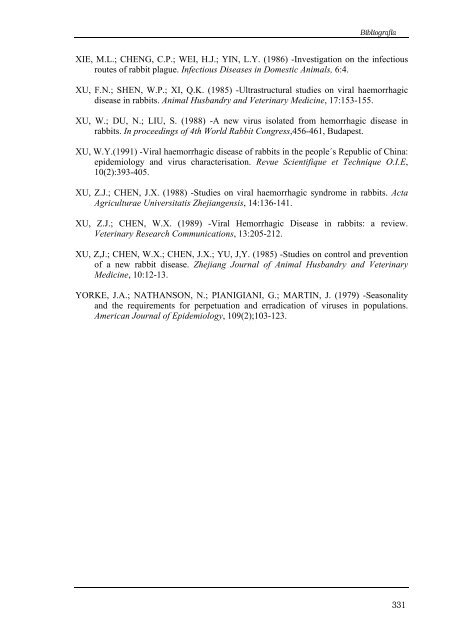EPIDEMIOLOGIA DE ENFERMEDAD HEMORRAGICA ... - citaREA
EPIDEMIOLOGIA DE ENFERMEDAD HEMORRAGICA ... - citaREA EPIDEMIOLOGIA DE ENFERMEDAD HEMORRAGICA ... - citaREA
Bibliografía 330 the presence of rabbit fleas (Spilopsyllus cuniculi Dale) and virulent myxoma virus. Journal of Applied Ecology, 10:417-427. WILLIAMS, R.T.; PARER, I. (1972) -The status of myxomatosis at Urana, New South Wales, from 1.968 until 1.971. Australian Journal of Zoology, 20:391-404. WILLIAMS, R.T.; PARER, I. (1971) -Observations on the dispersal of the european rabbit flea, Spilopsyllus cuniculi (Dale), through a natural population of wild rabbits, Oryctolagus cuniculus (L.). Australian Journal of Zoology, 19:129-140. WODZICKI, K. (1960) -Influence of population density on the adrenal and body weights of the wild rabbit Oryctolagus cuniculus L. in new Zealand. New Zealand Journal of Science, 3:103-120. WOOD, D.H. (1980) -The demography of a rabbit population in an arid region of new south Wales Australia. Journal of Animal Ecology, 49:55-79. WOOD, D.H. (1988) -Estimating rabbit density by counting dung pellets. Australian Wildlife Research, 15:665-671.
Bibliografía XIE, M.L.; CHENG, C.P.; WEI, H.J.; YIN, L.Y. (1986) -Investigation on the infectious routes of rabbit plague. Infectious Diseases in Domestic Animals, 6:4. XU, F.N.; SHEN, W.P.; XI, Q.K. (1985) -Ultrastructural studies on viral haemorrhagic disease in rabbits. Animal Husbandry and Veterinary Medicine, 17:153-155. XU, W.; DU, N.; LIU, S. (1988) -A new virus isolated from hemorrhagic disease in rabbits. In proceedings of 4th World Rabbit Congress,456-461, Budapest. XU, W.Y.(1991) -Viral haemorrhagic disease of rabbits in the people´s Republic of China: epidemiology and virus characterisation. Revue Scientifique et Technique O.I.E, 10(2):393-405. XU, Z.J.; CHEN, J.X. (1988) -Studies on viral haemorrhagic syndrome in rabbits. Acta Agriculturae Universitatis Zhejiangensis, 14:136-141. XU, Z.J.; CHEN, W.X. (1989) -Viral Hemorrhagic Disease in rabbits: a review. Veterinary Research Communications, 13:205-212. XU, Z,J.; CHEN, W.X.; CHEN, J.X.; YU, J,Y. (1985) -Studies on control and prevention of a new rabbit disease. Zhejiang Journal of Animal Husbandry and Veterinary Medicine, 10:12-13. YORKE, J.A.; NATHANSON, N.; PIANIGIANI, G.; MARTIN, J. (1979) -Seasonality and the requirements for perpetuation and erradication of viruses in populations. American Journal of Epidemiology, 109(2);103-123. 331
- Page 289 and 290: RESUMEN 279
- Page 291 and 292: 7-RESUMEN Resumen El conejo silvest
- Page 293: Resumen Los resultados del modelo i
- Page 296 and 297: Bibliografía 286
- Page 298 and 299: Bibliografía ANDREWES, C.H.; MUIRH
- Page 300 and 301: Bibliografía BORG, B.; ANDERSSON,
- Page 302 and 303: Bibliografía COLLINS, B.J.; WHITE,
- Page 304 and 305: Bibliografía CHASEY, D.; TROUT, R.
- Page 306 and 307: Bibliografía DUFF, J.P.; CHASEY, D
- Page 308 and 309: Bibliografía FENNER, F.; MARSHALL,
- Page 310 and 311: Bibliografía GARSON, P.J. (1986) -
- Page 312 and 313: Bibliografía GRANZOW, H.; WEILAND,
- Page 314 and 315: Bibliografía KELLEY, K.W. (1980) -
- Page 316 and 317: Bibliografía LAVAZZA, A.; SCICLUNA
- Page 318 and 319: Bibliografía LLOYD, H.G. (1963) -I
- Page 320 and 321: Bibliografía MORISSE, J.P. (1989)
- Page 322 and 323: Bibliografía MYERS, K. PARER, I.;
- Page 324 and 325: Bibliografía MYKYTOWYCZ, R.; FULLA
- Page 326 and 327: Bibliografía OPGENORTH, A.; NATION
- Page 328 and 329: Bibliografía PEETERS, J.E.; VANDER
- Page 330 and 331: Bibliografía ROSS, J. (1982) -Myxo
- Page 332 and 333: Bibliografía SHEPHERD, R.C.H.; EDM
- Page 334 and 335: Bibliografía 324 population of sno
- Page 336 and 337: Bibliografía SORIGUER, R.C.; ROGER
- Page 338 and 339: Bibliografía TYNDALE-BISCOE, C.H.;
Bibliografía<br />
XIE, M.L.; CHENG, C.P.; WEI, H.J.; YIN, L.Y. (1986) -Investigation on the infectious<br />
routes of rabbit plague. Infectious Diseases in Domestic Animals, 6:4.<br />
XU, F.N.; SHEN, W.P.; XI, Q.K. (1985) -Ultrastructural studies on viral haemorrhagic<br />
disease in rabbits. Animal Husbandry and Veterinary Medicine, 17:153-155.<br />
XU, W.; DU, N.; LIU, S. (1988) -A new virus isolated from hemorrhagic disease in<br />
rabbits. In proceedings of 4th World Rabbit Congress,456-461, Budapest.<br />
XU, W.Y.(1991) -Viral haemorrhagic disease of rabbits in the people´s Republic of China:<br />
epidemiology and virus characterisation. Revue Scientifique et Technique O.I.E,<br />
10(2):393-405.<br />
XU, Z.J.; CHEN, J.X. (1988) -Studies on viral haemorrhagic syndrome in rabbits. Acta<br />
Agriculturae Universitatis Zhejiangensis, 14:136-141.<br />
XU, Z.J.; CHEN, W.X. (1989) -Viral Hemorrhagic Disease in rabbits: a review.<br />
Veterinary Research Communications, 13:205-212.<br />
XU, Z,J.; CHEN, W.X.; CHEN, J.X.; YU, J,Y. (1985) -Studies on control and prevention<br />
of a new rabbit disease. Zhejiang Journal of Animal Husbandry and Veterinary<br />
Medicine, 10:12-13.<br />
YORKE, J.A.; NATHANSON, N.; PIANIGIANI, G.; MARTIN, J. (1979) -Seasonality<br />
and the requirements for perpetuation and erradication of viruses in populations.<br />
American Journal of Epidemiology, 109(2);103-123.<br />
331



